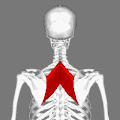Rhomboid muscles
| Rhomboid muscle | |
|---|---|
dorsal scapular artery | |
| Nerve | dorsal scapular nerve |
| Actions | Pulls scapulae medially, rotates scapulae, holds scapulae into thorax wall |
| Identifiers | |
| Latin | musculi rhomboidei |
| TA98 | A04.3.01.007 A04.3.01.008 |
| TA2 | 2232, 2233 |
| Anatomical terms of muscle] | |
The rhomboid muscles (/ˈrɒmbɔɪd/), often simply called the rhomboids, are rhombus-shaped muscles associated with the scapula. There are two rhomboid muscles on each side of the upper back:[1][2][3]
The large rhombus-shaped muscle, located under the trapezius muscle in the upper part of the thoracic region of the back, and the small muscle, in the same way, participate in the movement of the scapula.[4] Their functions are the following:[1][2][3]
- Drawing scapula superomedially
- Supporting scapula
- Rotating glenoid cavity inferiorly
Both muscles are
Additional images
-
Rhomboid muscles.
-
Rhomboid muscles.
-
Left scapula. Posterior surface.
-
Full back muscle flex
...
References
- ^ OCLC 920806541.
- ^ OCLC 813301028.
- ^ a b c "Rhomboid muscles". Kenhub. Retrieved September 27, 2019.
- ^ "Rhomboid Muscle Pain". RhomboidMusclePain. Retrieved November 13, 2019.
Wikimedia Commons has media related to Rhomboid muscles.




